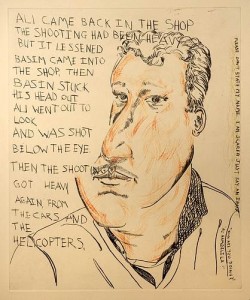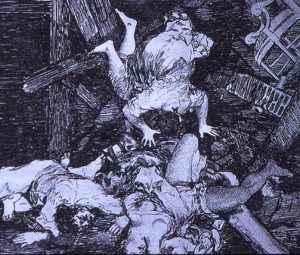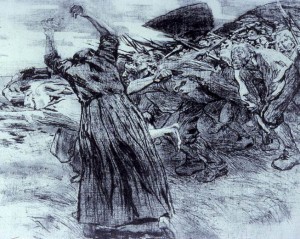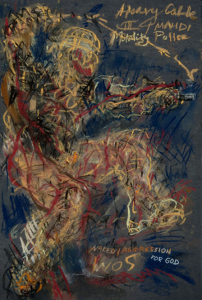My imaginary interview with Amy Goodman on Culture and Resistance
Amy Goodman featured “Culture and Resistance” today.
I love Democracy Now and I love Amy Goodman, but this show was notable for what was not included: visual artists!
In my opinion it also reflected an East Coast bias, in omitting the voices of Latinos, Asians Americans, Indigenous artists in any media.
Now Amy is great on covering issues across the whole spectrum of the US, so it is odd that for this show she omitted so many possible perspectives on “Culture and Resistance.”
I started to imagine Amy Goodman interviewing me. My fantasy interview
AG Tell us why visual artists are so important in resistance.
SNP Visual artists make visible the invisible. All of the artists that I write about give us insights that they have gained through their lives, their experiences and their obsessions about injustice in the world. They bring a highly attuned aesthetic sense to shape their images in such a way as to make that injustice penetrate into our souls
AG How did you decide which artists to include in your book “Art and Politics Now, Cultural Activism in a Time of Crisis”?
SNP I followed the issues and grouped artists according to those concerns, such as Resisting Police States, Women, War and Imperialism, Exposing Racism, Crossing Borders, Ecology. I often had a few artists in mind whose work I had followed for many years, then I would add other artists as they emerged during the years I was writing the book . I began the book just after 9/11 and continued to work on it until 2010, It was going to press during the BP Gulf Oil Spill. I include artists of many different perspectives, but I tried not to ghettoize ethnicity, but focus on the issues addressed, which are frequenly shared by everyone.
AG You dedicated your book to Selma Waldman. Tell us about her.
SNP Selma Waldman died in 2008 as I was finishing the book. She was absolutely committed in her art to making injustice visual as well as to honoring those who helped to do that.
Selma grew up in Kingsville, Texas, as the daughter of the only Jewish family in that city, and going to school with many farmworkers children. She learned early about injustice. In 1960 she went to Berlin on a Fulbright Fellowship and saw the movie “Mein Kampf” as well as the front page stories about the massacres in Sharpesville, South Africa that year.
She decided to dedicate her art to addressing injustice, beginning with the “falling man” based on photographs of holocaust victims. For many years her work addressed apartheid in South Africa and other Civil Rights issues around the world. She always had a global perspective on injustice. In her last months she completed 180 chalk drawings on black notebook paper of specific examples of torture at Guantanamo and Abu Ghraib. She called the series, “Black Book of Aggressors” Right before she died she planned another series based on Goya’s “Saturn Devouring His Children,” in which she referred to war devouring people in conflicts all over the globe. Her work is in the grand tradition of Goya and Kathe Kollwitz, two artists who unflinchingly represented the horrors of war.
AG In your book, “Art and Politics Now” you include other artists who represented Abu Ghraib torture.
SNP Yes. There are several, and of course they only represent a sample. I chose two others Fernando Botero and Daniel Heyman. The revelations via the internet, 60 minutes, and Stuart Hirsch’s article in the New Yorker came out in 2004. Colombian artist Fernando Botero made a series of paintings and drawings that translated the raw photographsas well as other sources into paintings in his characteristic inflated bodies. He declared he wanted to give the prisoners moral weight that made them heroic. Botero is best known for painting happy bourgeois small town people, but he has frequently addressed injustice such as the military junta in Columbia, and the drug cartels. That aspect of his career is not as well known.

Another artist in the book representing Abu Ghraib, Daniel Heyman,
is not as well known internationally.
He accompanied a team of lawyers who were preparing a class action lawsuit against two corporate contractors who provided Abu Ghraib with interrogators and translators. Heyman’s portraits give us men who had been released from Abu Ghraib, often disabled. He sat in on interviews in Istanbul, Turkey, and not only drew portraits but also recorded the words of the released prisoners, none of whom had ever been accused of a crime. Only this week that lawsuit was successful! The 71 released prisoners won over 5 million dollars from military contractors who organized the abuse. There is also a second suit pending.
AG We are just about out of time. What would you like to leave us with?
SNP Artists who make visual the pressing concerns of the world have a deep commitment to justice. They work in many different styles and media of art. Usually, these artists have chosen to represent injustice in spite of their art school training, which usually encourages artists to create aesthetic objects with technical sophistication, objects that represent only the artist’s personal identity and can be sold on a capitalist art market. Many of the artists I write about are also successful in selling their work (some choose not to sell it), but that is not as important to them as the fact of raising their voices against injustice.
Last, I would like to say that this is not new in American art. During the 1930s artists were also deeply committed to representing injustice, a story that I tell in my previous book, Art and Politics in the 1930s. These contemporary artists work in a tradition that is powerful, but that is generally suppressed in the media and in art history and art criticism. I write about these artists ( also on my blog of the same name) in order to increase understanding of the issues they represent and how these extraordinary artists have contributed to that understanding.
AG Thank you Susan Noyes Platt. We will continue this conversation soon!
This entry was posted on January 1, 2013 and is filed under Art and Activism, Art and Politics Now, art criticism, Art in War, Art of Democracy.











